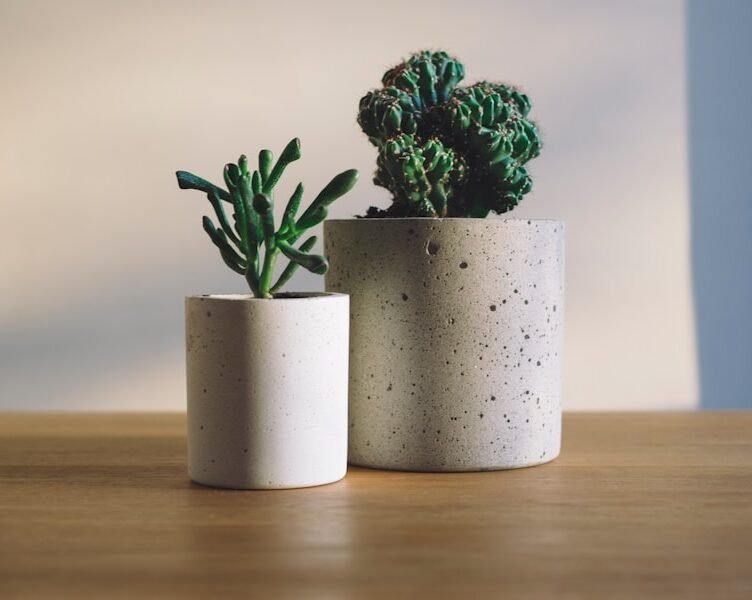Indoor plants have been proven to have a multitude of benefits for individuals of all ages, including children. Beyond adding a natural touch to indoor spaces, they have the potential to enhance children’s well-being in several ways. Scientific research has demonstrated that indoor plants can reduce stress, anxiety, and improve concentration and productivity.
For children, who are frequently exposed to various stressors such as academic pressures, social demands, and technology, having indoor plants in their environment can provide a calming and relaxing atmosphere. Moreover, indoor plants can also purify the air, which is particularly beneficial for children who may suffer from allergies or respiratory issues. Overall, the presence of indoor plants in a child’s environment can contribute significantly to their overall well-being and happiness.
In addition, indoor plants can serve as an educational tool for children. By caring for indoor plants, children can learn valuable lessons about responsibility, patience, and the importance of nurturing living organisms. This can instill empathy and compassion in children as they learn to care for and appreciate the natural world around them.
Furthermore, having indoor plants in a child’s environment can encourage them to spend more time outdoors and appreciate nature. This is particularly beneficial in today’s digital age, where children often spend excessive amounts of time on screens and may have limited exposure to the natural world. Overall, the benefits of indoor plants for children’s well-being are numerous and can have a profoundly positive impact on their overall happiness and development.
Key Takeaways
- Indoor plants can help improve your child’s mood and happiness by creating a positive environment and reducing stress and anxiety.
- The benefits of indoor plants for children’s well-being include improved air quality, increased relaxation, and enhanced concentration.
- Top 5 indoor plants to boost your child’s mood are aloe vera, snake plant, peace lily, spider plant, and English ivy.
- Incorporating indoor plants into your child’s daily routine can lead to improved happiness and emotional well-being.
- When choosing and caring for indoor plants in a child’s room, consider factors such as safety, maintenance, and the child’s preferences.
How Indoor Plants Can Improve Children’s Mood and Happiness
Reducing Stress and Anxiety
For children, who may experience various stressors in their daily lives, having indoor plants in their environment can provide a sense of calm and tranquility.
Inspiring Creativity and Connection
The natural beauty of indoor plants can also serve as a source of inspiration and creativity for children, as they observe the growth and development of the plants over time. In addition, indoor plants can also help improve children’s mood by providing a sense of connection to nature. Research has shown that exposure to nature can have a positive impact on mental health, and having indoor plants in a child’s environment can help bridge the gap between the indoors and the natural world.
Boosting Happiness and Well-being
This can help children feel more grounded and connected to the world around them, which can contribute to their overall happiness and well-being. Overall, the presence of indoor plants in a child’s environment can have a significant impact on their mood and happiness, providing them with a sense of calm, inspiration, and connection to nature.
Top 5 Indoor Plants to Boost Your Child’s Mood
When it comes to choosing indoor plants for children, there are several options that are known for their mood-boosting properties. One popular choice is the snake plant, which is known for its air-purifying abilities and low maintenance requirements. The snake plant is also known for its ability to thrive in low light conditions, making it an ideal choice for children’s bedrooms or play areas.
Another popular choice is the peace lily, which is known for its beautiful white flowers and ability to improve air quality. The peace lily is also relatively easy to care for, making it a great option for children. In addition to the snake plant and peace lily, other indoor plants that can help boost children’s mood include the spider plant, pothos, and rubber plant.
The spider plant is known for its ability to remove toxins from the air and is also safe for pets, making it a great choice for families with animals. The pothos is another popular choice, known for its trailing vines and ability to thrive in various lighting conditions. Lastly, the rubber plant is known for its large, glossy leaves and ability to thrive in low light conditions.
Overall, these top 5 indoor plants are great options for boosting children’s mood and happiness while adding a touch of nature to their indoor spaces.
Creating a Positive Environment with Indoor Plants for Children
| Plant Name | Benefits |
|---|---|
| Lavender | Calming effect, reduces stress and anxiety |
| Aloe Vera | Purifies air, easy to care for |
| Spider Plant | Improves air quality, reduces toxins |
| Rubber Plant | Increases humidity, removes toxins |
| Peace Lily | Improves air quality, reduces mold spores |
Incorporating indoor plants into a child’s environment can help create a positive and nurturing space that promotes their overall well-being. By adding greenery to their bedrooms, play areas, or study spaces, parents can help create a calming and inspiring environment for their children. The presence of indoor plants can help reduce stress and anxiety, while also providing a sense of connection to nature.
This can help create a positive atmosphere that encourages creativity, relaxation, and overall happiness for children. Furthermore, incorporating indoor plants into a child’s environment can also serve as a learning opportunity. Parents can involve their children in caring for the plants, teaching them about responsibility, patience, and the importance of nurturing living things.
This can help instill a sense of empathy and compassion in children while also providing them with a hands-on learning experience. Overall, creating a positive environment with indoor plants for children can have numerous benefits for their overall well-being and happiness.
The Science Behind How Indoor Plants Affect Children’s Emotions
The science behind how indoor plants affect children’s emotions lies in their ability to reduce stress and anxiety while promoting a sense of calm and well-being. Research has shown that exposure to nature has a positive impact on mental health, and indoor plants can help bridge the gap between the indoors and the natural world. The presence of greenery in indoor spaces has been linked to improved mood and overall well-being, as well as reduced stress levels.
This is due to the calming effect that nature has on the human mind, which can help children feel more grounded and connected to the world around them. In addition, indoor plants also have the ability to improve air quality, which can have a direct impact on children’s emotions. Poor air quality has been linked to various health issues, including respiratory problems and decreased cognitive function.
By purifying the air and removing toxins, indoor plants can help create a healthier indoor environment that promotes overall well-being for children. This can contribute to improved mood and happiness by providing children with a clean and healthy space to thrive in. Overall, the science behind how indoor plants affect children’s emotions lies in their ability to reduce stress, improve air quality, and provide a sense of connection to nature.
Tips for Choosing and Caring for Indoor Plants in a Child’s Room
Low-Maintenance Plants for Busy Kids
Opt for plants that can thrive in various lighting conditions and require minimal upkeep, such as snake plants or pothos. These plants are easy to care for and can withstand occasional neglect, making them perfect for children’s rooms.
Safety First: Pet-Friendly Options
When choosing plants, consider the safety of your child and pets. Avoid toxic plants like philodendron or dieffenbachia, and instead opt for pet-friendly options like spider plants or Boston ferns.
Proper Care for Happy Plants
To keep plants healthy and thriving, provide them with proper light, water, and nutrients. Place plants near windows or under artificial grow lights to ensure they receive enough light. Water plants regularly, but avoid overwatering, which can lead to root rot and other issues. Finally, fertilize plants occasionally with a balanced fertilizer to provide necessary nutrients. By following these simple tips, parents can create a green and healthy environment that promotes their child’s overall well-being and happiness.
Incorporating Indoor Plants into Your Child’s Daily Routine for Improved Happiness
Incorporating indoor plants into your child’s daily routine can help promote their overall happiness and well-being. Encourage your child to take an active role in caring for the plants by watering them, checking for signs of growth, and providing them with proper light. This can help instill a sense of responsibility and appreciation for nature in your child while also providing them with a hands-on learning experience.
Additionally, consider incorporating activities such as gardening or plant-related crafts into your child’s routine to further promote their connection to nature. Furthermore, consider using indoor plants as a tool for relaxation and mindfulness in your child’s daily routine. Encourage your child to spend time near the plants while reading or doing homework, as this can help promote a sense of calm and tranquility.
Additionally, consider incorporating plant-related activities such as meditation or yoga into your child’s routine to further promote their overall well-being. By incorporating indoor plants into your child’s daily routine in these ways, you can help improve their mood and happiness while providing them with valuable life skills and experiences. In conclusion, indoor plants have numerous benefits for children’s well-being and happiness.
From reducing stress and anxiety to promoting a sense of connection to nature, indoor plants can have a significant impact on children’s emotions and overall well-being. By choosing the right plants, creating a positive environment, understanding the science behind how indoor plants affect emotions, and incorporating them into your child’s daily routine, you can help promote their overall happiness while providing them with valuable learning experiences. Overall, indoor plants are an excellent addition to any child’s environment and can contribute to their overall well-being in numerous ways.
FAQs
What are the benefits of indoor plants for children’s mood and happiness?
Indoor plants can help improve children’s mood and happiness by reducing stress, anxiety, and fatigue. They can also improve air quality, increase relaxation, and provide a sense of nurturing and responsibility.
Which indoor plants are best for improving children’s mood and happiness?
Some indoor plants that can help improve children’s mood and happiness include the snake plant, peace lily, spider plant, aloe vera, and English ivy. These plants are known for their air-purifying properties and low maintenance.
How do indoor plants improve air quality in the home?
Indoor plants can improve air quality by absorbing carbon dioxide and releasing oxygen through the process of photosynthesis. They can also remove toxins such as formaldehyde, benzene, and trichloroethylene from the air, creating a healthier indoor environment for children.
Are there any safety concerns with having indoor plants around children?
While most indoor plants are safe for children, some plants can be toxic if ingested. It’s important to research the specific plants and keep them out of reach of young children. Additionally, some children may have allergies to certain plants, so it’s important to monitor their reactions.
How can parents incorporate indoor plants into their children’s environment?
Parents can incorporate indoor plants into their children’s environment by placing them in common areas such as the living room, playroom, or bedroom. They can also involve children in caring for the plants, teaching them about responsibility and nurturing.






